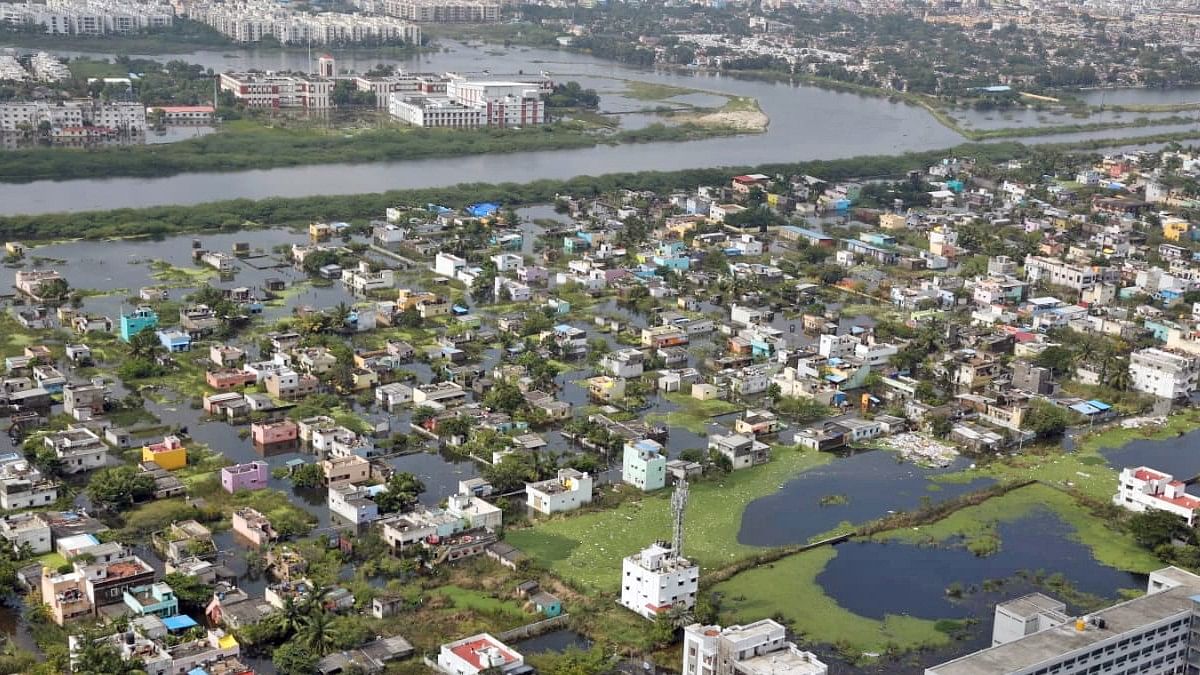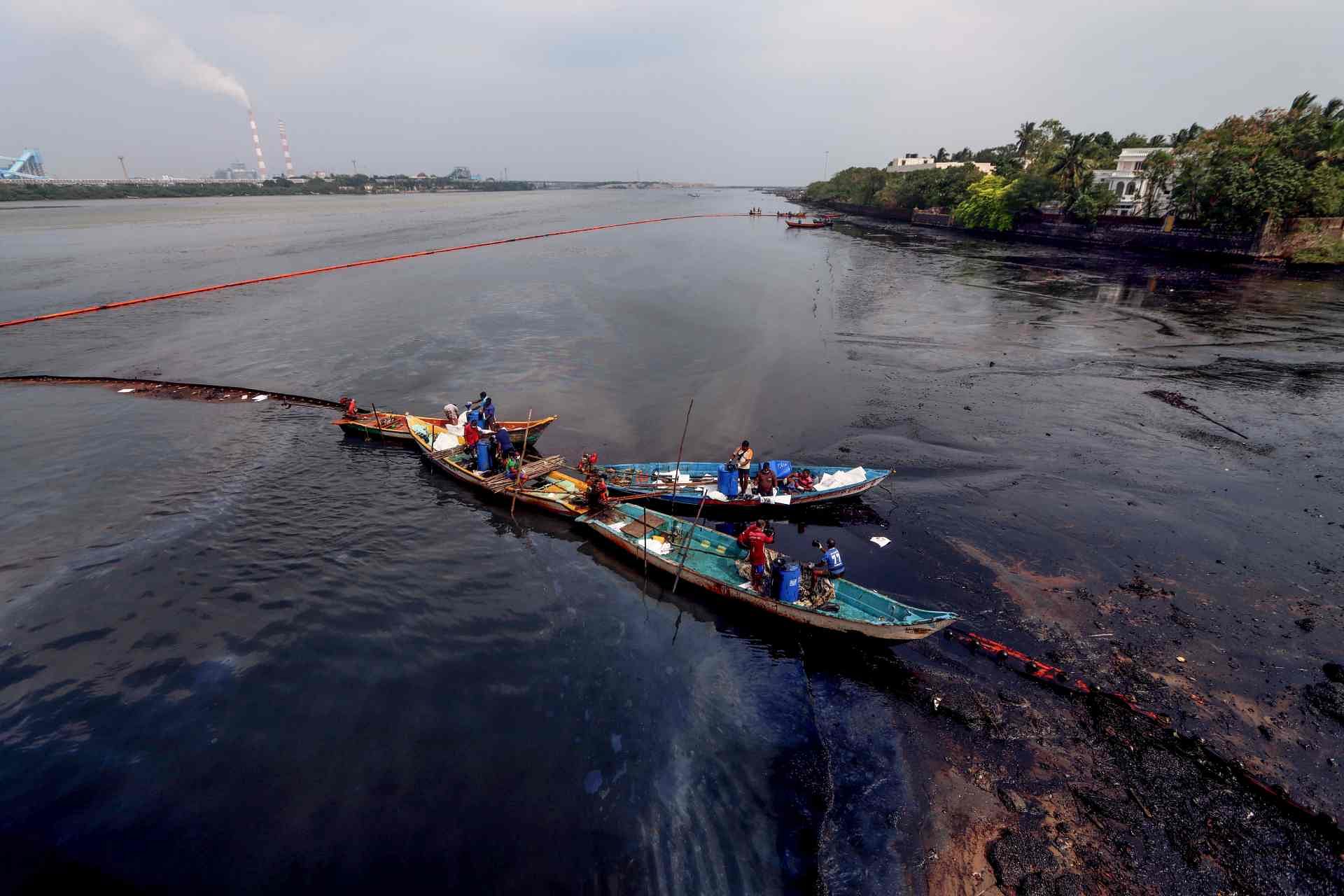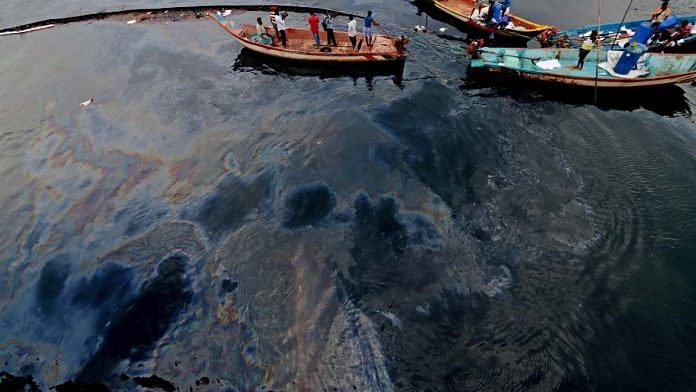Chennai: Three weeks since Cyclone Michaung caused a massive oil spill in Chennai’s Ennore creek, there is concern that the clean-up, which remains under way, may not be the end of the ordeal for local residents.
“Most of the people in the region don’t know the gravity of the situation, and they are even unaware of the substances in the oil that has breached their homes,” said Prabakaran Veeraarasu, an environment engineer associated with Poovulagin Nanbargal, a Chennai-based environmental organisation.
“People lived in the houses with the sludge for close to five days until it was removed,” he added, saying a test had established the presence of benzene, toluene, and styrene in the oil.
Long-term exposure to these chemicals has been linked with cancer, besides liver and kidney issues, he said.
Prabakaran said a field study conducted by his team after the cyclone had led them to several people who had developed skin-related issues and rashes, as well as swelling in hands, and were experiencing a burning sensation in their chest and eyes. “Many children got high fever,” he said. “There will be a lot of long-term impact with regard to the health of the people in the region.”
While the Tamil Nadu government is conducting a health assessment in affected areas, questions have arisen about its handling of the crisis.
Fishermen who depend on the Ennore creek have said the compensation amount is inadequate to get them back on their feet, and environmentalists have flagged the absence of a contingency plan for oil spills in Tamil Nadu, which they say delayed the clean-up and worsened the situation.
But the loudest note of concern surrounds the crucial ecosystem comprising the creek, which forms the backwater of the Kosasthalaiyar river.
The creek is part of the Ennore-Pulicat wetland system, which also comprises the Karungali estuary and Pulicat lake. The system together acts as an ecological unit that protects biodiversity and recharges groundwater. Environmentalists credit the system for ensuring north Chennai wasn’t completely marooned during the floods caused by Michaung.
As 45,000 cusecs of water was released from the Poondi and Puzhal reservoirs, the wetland system absorbed the excess flood water.
The wetlands are also home to many rare migratory birds.
However, once spread over 10,000 acres, the system has shrunk due to rampant encroachments by public sector undertakings.
In July 2022, activists say, the National Green Tribunal (NGT) had ordered the TN government to declare this wetland protected.
“Though the NGT order came in July 2022, it has still not been implemented. The physical plight of the creek before the chemical hazard was encroachment,” said environmentalist Nithyanand Jayaraman.
“Now, once the visible traces of oil disappear, the wetland will once again go back to its deadly normal — a state of being in the intensive care unit (ICU).”
Reached for comment, Supriya Sahu, the additional chief secretary for the environment, climate change and forest department, said the notification process of the wetland will be completed soon.
The focus right now is the clean-up, she added.
Also Read: As Tamil Nadu battles floods, Sitharaman, DMK govt in war of words over disaster relief
‘Not definitely normal’
The oil spill happened on 4 December as Michuang battered Chennai with heavy wind and rains. Oil from a refinery of the public-sector Chennai Petroleum Corporation Limited (CPCL) spilled into Buckingham Canal, also a part of the wetland system, and Ennore creek.

On 20 December, Sahu said the emergency oil recovery work had been completed.
However, the government has told the NGT that work in the mangrove area of the creek will take more time. Sixty fisher boats will continue to perform localised cleaning, with another 20 vessels deployed exclusively for the mangrove areas until January.
The oil spill stoked a crisis in the creek’s neighbourhood. In Ernavoor, water mixed with oil sludge rose as high as five feet and seeped into most houses.
A viral video showed residents walking chest-deep in oil-laden sludge amid evacuation efforts.
Speaking to ThePrint, Sahu said local residents had been impacted by the spill in two ways.
“[First are] villages where the water went inside their homes. And the second are fishermen, whose boats, nets got coated with the oil and were also prevented from fishing as the Ennore creek area was affected.”
M. Anandan, a 73-year-old resident of the area, said the water-oil mixture had risen neck-deep inside his home, and left sludge marks in several parts. “We need a lot of cleaning before we can stay here again. The smell is unbearable, after a few hours the chest feels heavy,” he said, adding that he is living with a relative while the clean-up is in progress.
Sahu acknowledged that the situation in Ennore is “not definitely normal”, adding that the state government and the CPCL have set up different medical teams to screen people.
“We are reaching out to a few doctors through the state’s health secretary to see if we can take up a long-term impact study on the health of the residents here and that is in progress,” Sahu added.
Meanwhile, fisherfolk said they will reel under the impact for the next six to eight months at least. Almost all the fish in the region have died, and nobody is willing to buy the other fish as “it is oil soaked”, they added.
“Also all the nets and boats are damaged,” Anandan said.
As directed by the NGT, the chief minister Saturday announced compensation for the 9,001 families affected in the region. This includes Rs 12,500 each for the 2,301 families from fishing villages and Rs 10,000 per boat for repairs.
It is far from adequate, local fisherfolk said, adding that their boats were most likely beyond repair.
Muthu R, a resident of Kattukuppam, said their nets “cannot be used again and the boats soaked in oil will start cracking once it dries and gets sunlight”.
“Even a diesel leak damages fibre boats, which expands in the heat. Imagine the whole boat is now soaked in oil,” he added. “Each boat without a motor costs between Rs 1.5 lakh and 3 lakh. What will we do with just Rs 10,000 per boat?”
Also Read: This is the science behind how incidents of oil spills damage our environment
‘No state contingency plan for oil spill in TN’
In 1996, a national contingency plan for oil spills was introduced. Based on the national policy, each state was supposed to come up with its own contingency plan but Tamil Nadu still does not have one, said M. Vetriselvan, an environmentalist with Poovulagin Nanbargal.
Under the contingency plan, the first authority to respond to an oil spill is the Coast Guard, followed by the Oil and Natural Gas Corporation (ONGC). Then other departments in coordination with the state government get involved.
Without a proper plan in place, when the oil spill was reported on 4 December, there was no response, say activists.
“This is an industrial accident, and people reported it on 4 and 5 December. It was only on 6 December that the Tamil Nadu Pollution Control Board (TNPCB) reached the site. TNPCB in its first report said ‘there are only traces of oil’ and it diluted the issue,” said Vetriselvan.
Prabakaran said both CPCL and TNPCB should be held responsible for “delaying the response during the disaster’s golden hour”, which is the first few hours after the spill.
Jayaraman added that the entire operation from the government’s end “has been a learning-as-you-go exercise”.
“It is not as per any established protocol. Established protocol would have required an immediate response within a day to contain the damage to cut off the source and then to deploy a crew that is trained in dealing with spills and chemical hazards.”
In Ennore, environmentalists say, fishermen were hired over the first two days as daily labour by CPCL, and asked to start cleaning up without basic safety equipment.
“For an oil spill of this nature, where you are dealing with a lot of airborne gasses and particulate matter, you need masks that can filter the particulate matter — not the ordinary Covid mask or the N95,” said Jayaraman.
Asked about the contingency plan, Sahu said a draft was formulated in 2017 and is awaiting approval from the Coast Guard.
She said the Coast Guard and the state have been working on the finer details of the plan, which was drafted after a spill caused by a collision between two cargo vessels off Kamarajar Port.
Sahu said the plan, whose details are not publicly available, “is in the correspondence stage”.
“The Coast Guard has raised certain queries like having certain equipment for tackling an oil spill already procured by the state. We responded that once the draft is passed, the required equipment will be purchased etc,” she added. “Even during this spill, we have referred to [certain] SOPs given in the draft as it is prepared to tackle such a scenario and has inputs from all stakeholders.”
Sahu said, however, that the “coast guard was immediately alerted to the spill” but operations were delayed by certain factors.
“The tide was very high and only after the current subsided were we able to see the impact of the oil spill. Additionally, this is the first time where the spill happened in the creek and the Coast Guard’s equipment was not able to come into the shallow creek area,” she added.

A creek area, Sahu said, is highly impacted due to low and high tides and there were no SOPs for the same.
“The general SOPs for clean-up around a refinery or storage area were not applicable for the creek region,” Sahu said, adding that this led to the cleaning team jumping into the oily waters.
Sahu said while the oil spill management group had physically met only five to six days after the incident, the chief minister and chief secretary had been taking daily reviews from the day it was reported.
Along with the Coast Guard, and revenue, environment and various other departments as well as local bodies, the state has formed an immediate oil spill coordination centre to oversee the cleaning operation, she said.
“The entire cleaning operation was undertaken by four specialised agencies… with the deployment of 128 boats,” she added, saying several other kinds of equipment like excavators, oil boomers (floating barriers that contain the spill) and oil skimmers aided the effort.
Until 20 December, she said, 105.82 kilolitres of oily water and 393.5 tonnes of oily sludge had been removed.
The bigger issue
As the cleaning op continues, environmentalists say the region faces bigger questions, including how residential areas were permitted within a one-kilometre radius of a “red-category industry like CPCL”.
The oil produced here is highly inflammable, and also the waste from here is toxic, said Vetriselvan. Jayaraman added that the existence of residential areas so close by to CPCL shows that “the departments concerned are not serious about zoning”.
Environmentalists have also repeatedly flagged encroachments in the wetlands.
In 2020, the Save Ennore Creek campaign, in a report to Union Home Minister Amit Shah, alleged that more than 660 acres of the backwater had been encroached by public sector undertakings.
The Kamarajar Port, it claimed, had encroached 114 acres, while the coal ash dump for NTPC Tamil Nadu Energy Company Ltd (NTECL) took up 203 acres, and Bharat Petroleum another 100 acres.
Sahu said the process to notify the wetland as protected is under way, adding that its sanctity was best summarised by an elderly fisherman they met during the clean-up.
“After a long day’s work, he told us, ‘Soon the oil in the area will be cleared and cleaned up. But your work to safeguard the creek here is a never-ending process’,” she said, quoting the fisherman. “‘She (creek) is our lifeline’.”
(Edited by Sunanda Ranjan)
Also Read: With pails and mugs, Philippine residents clean up oil spill



